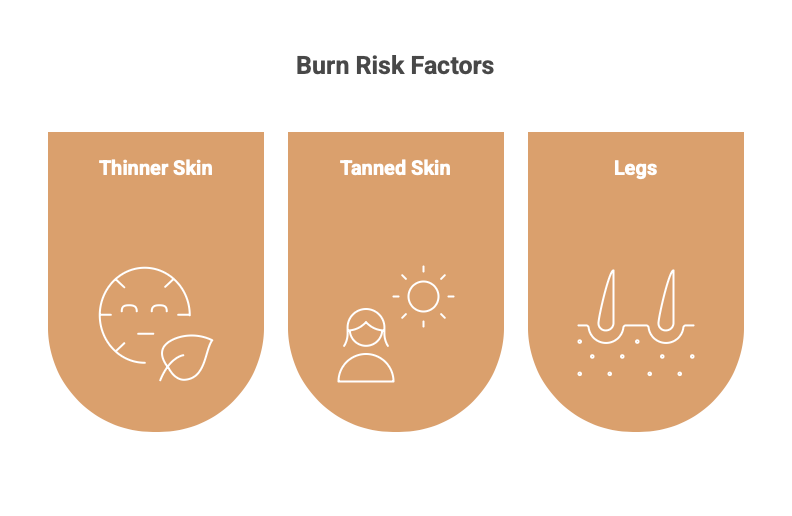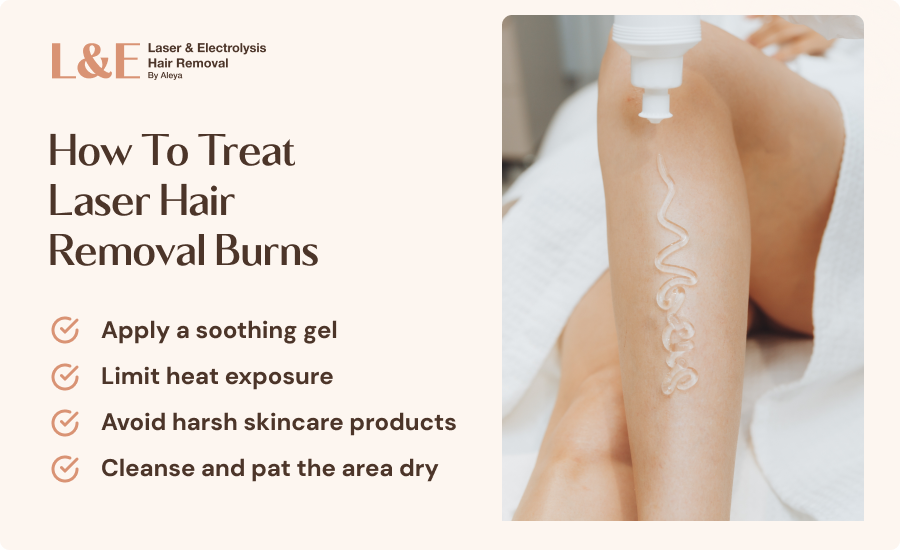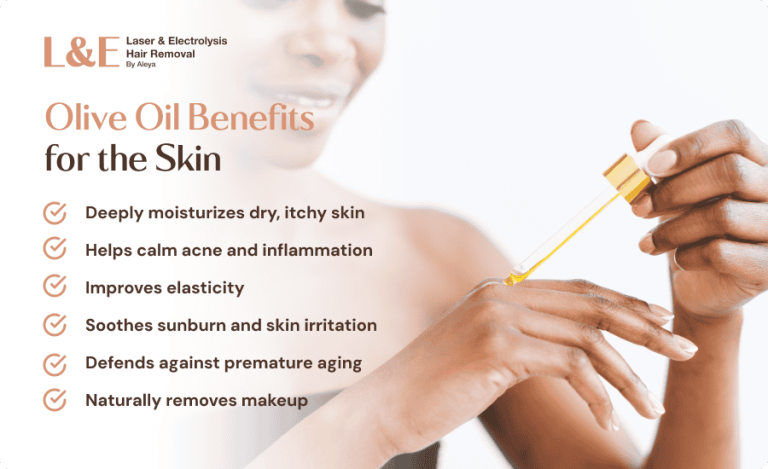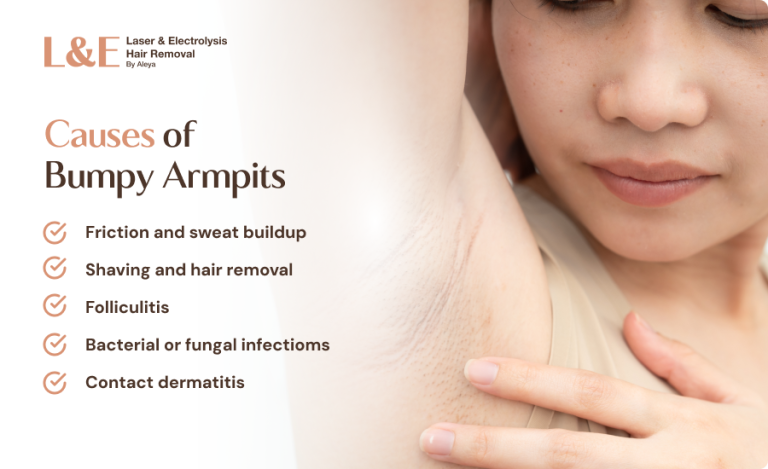Who’s Most at Risk for Laser Hair Removal Burns? [+ FAQs]
![Who’s Most at Risk for Laser Hair Removal Burns? [+ FAQs]](https://www.laserbyaleya.com/wp-content/uploads/2025/07/laser-hair-removal-burns-hero-image.png)
Laser Hair Removal Burns: Key Takeaways
- Burns from laser hair removal typically happen when the laser lingers too long, the cooling gel isn’t applied properly, or the skin absorbs too much heat
- Laser burns are most common on thin skin, tanned areas with extra melanin, and the legs, where stronger laser settings target coarse hair
- If you experience a laser burn on your skin, cool the area immediately and apply a soothing gel, such as aloe vera
Did you know that darker skin tones can be more sensitive to burns if the laser technician isn’t properly trained?
With the right laser technology and expert care, laser hair removal is safe and effective for most skin tones, but it’s crucial to understand how it works and to choose a qualified specialist.
In this article, we will:
- Understand the causes of laser hair removal burns
- Cover which areas of the body are most vulnerable to laser burns
- Share practical, step-by-step guidance on treating laser hair removal burns safely
- Introduce safe, expert-backed laser hair removal at Laser by Aleya for worry-free results
Why Some People Are More Prone to Laser Hair Removal Burns
Laser hair removal is generally safe, but some individuals are more vulnerable to burns due to factors such as skin tone or improper technique.
Here’s what increases your risk of laser hair removal burns:
1. Prolonged Laser Contact
If the laser stays on one spot for too long without proper cooling, the skin can quickly overheat and burn.
Fortunately, most modern laser devices use built-in cooling systems, such as chilled sapphire tips and cold air flow, that actively cool the skin before, during, and after each pulse, helping prevent burns.
2. Improper Use of Laser Gel
Most laser treatments use a conductive gel to help the device glide smoothly and protect the skin.
However, if the gel isn’t applied correctly or builds up on the applicator, it can cause problems.
In some cases, trapped debris on the device’s surface causes burns, and applying the laser before the gel fully dries increases the risk of skin damage.
3. Higher Levels of Melanin
Your skin’s natural pigment, called melanin, plays a big role in how your skin reacts to laser hair removal.
The laser is designed to target melanin in the hair follicle.
However, if your skin contains a high level of melanin, it might absorb excessive heat.
Here’s why skin tone matters:
- Darker skin tones and tanned skin contain more melanin, causing the laser to heat both the hair and the skin, which raises burn risk
- People with fair skin and dark hair are ideal candidates because the laser can easily target the hair follicle, reducing the risk of burns
- A greater contrast between hair and skin color makes treatment safer and more effective
Which Areas Are More Likely To Get Laser Burns?
Just like some areas feel more sensitive during laser treatments, certain parts of the body are also more likely to experience burns.
Here’s what you should know:
- Thinner skin: Burns are more common in places like the bikini line, face, neck, and genitals since these areas absorb heat more easily
- Tanned skin: If your skin has been exposed to the sun or tanning beds, it holds more melanin, making it more likely to burn during treatment
- Legs: A large area to cover, legs are a common trouble spot. They’re also often more sun-exposed and typically need higher laser settings for coarse hair

What Should You Do if You Get Laser Hair Removal Burns?
If you’re dealing with laser hair removal burns, here’s what you can do to help your skin heal safely and quickly.
1. Cool the Area Immediately
As soon as you notice burning or discomfort, apply a cold compress to the area. This helps pull heat out of the skin and reduce swelling.
- Do: Use a clean washcloth soaked in cool (not ice-cold) water, or a gel ice pack wrapped in a cloth. Apply for 10 to 15 minutes, repeating a few times throughout the day.
- Don’t: Place ice directly on your skin. This can cause further damage or frostbite.
2. Apply a Soothing Gel or Cream
Moisturize the area with soothing, fragrance-free products that help repair the skin barrier.
Pure aloe vera gel works well to cool the area, while over-the-counter 1% hydrocortisone cream can reduce redness and inflammation.
Skip heavily fragranced lotions, alcohol-based products, and essential oils; they might smell nice, but they can sting your skin and slow the healing process.
3. Avoid Heat, Sun, and Sweating
Give your skin a chance to heal by staying away from heat sources and UV rays, which can worsen irritation.
Skip the following for the first 48 to 72 hours:
- Hot showers
- Saunas
- Steam rooms
- Intense workouts that make you sweat
If your treated area is exposed, like your face or neck, protect it with a wide-brimmed hat or apply a broad-spectrum sunscreen with SPF 30 or higher once your skin starts to recover.
4. Skip Harsh Skincare Products
Your skin is in recovery mode, so avoid anything that could slow healing or cause additional irritation.
Take a break from retinoids, exfoliating scrubs, glycolic acid, salicylic acid, and strong anti-aging creams for at least one week.
For example, if you had laser treatment on your face, swap your exfoliating face wash for a mild, soap-free cleanser until any redness and sensitivity fade.
5. Keep the Area Clean and Dry
Wash the treated area gently twice a day using lukewarm water and mild, fragrance-free soap.
After washing, pat your skin dry with a soft towel and avoid rubbing or scrubbing.
If you notice any scabs or peeling, let them heal on their own, as picking at them can lead to scarring or infection.
If the area starts to ooze or blister, loosely cover it with sterile gauze and reach out to your provider for further care.
6. Watch for Signs of Infection
Most laser burns heal without complications, but an infection can develop if bacteria enter through damaged skin.
Look for:
- Increasing redness
- Swelling
- Yellow or green discharge
- Worsening pain
- Fever
If you notice any of these signs, reach out to your dermatologist as soon as possible to get the care your skin needs.
7. Follow Up With Your Laser Provider
Let your technician or dermatologist know about the burn so they can assess it, recommend care, and adjust your laser settings to prevent it from happening again.
For instance, if you experienced laser burns during your first session, they might lower the laser intensity or switch to a gentler device next time.

Get Safe, Effective Laser Hair Removal at Laser by Aleya
At Laser by Aleya, we believe your safety and comfort should never take a back seat.
That’s why we use advanced laser technology and personalize each treatment based on your skin tone, hair type (yes, even darker blonde hair), and sensitivity.
Aleya only follows the highest safety standards to help prevent burns, irritation, and unwanted pigmentation.
And with advanced lasers safe for most skin tones, you can trust you’re in expert hands from start to finish.
Laser Hair Removal Burns: FAQs
What causes burns during laser hair removal?
Burns from laser hair removal typically occur when the laser energy is absorbed by the skin instead of the hair follicle.
This can result from:
- Incorrect laser settings (too high for your skin type or hair color)
- Untrained or inexperienced technicians
- Recent sun exposure or tanning
- Certain medications or skincare products that increase skin sensitivity
- Underlying skin conditions not disclosed during consultation
What are the signs of a bad reaction to laser hair removal?
While uncommon, some people might experience more serious side effects like blisters, scabbing, or lasting changes in skin texture.
In rare cases, laser treatment can cause treated hairs to turn gray or trigger unexpected hair growth in nearby areas, especially on darker skin tones.
Will laser hair removal burns go away?
Yes, but it depends on how serious the burn is.
Mild laser burns, like redness or surface irritation, usually heal within a few days to two weeks with proper care.
Deeper burns might take weeks or even months to fully recover.
How can I prevent burns from laser hair removal?
To minimize your risk:
- Choose a reputable clinic with certified and experienced laser technicians
- Ensure a proper skin and hair assessment is done before treatment
- Avoid sun exposure, tanning beds, and self-tanners for at least two weeks before and after sessions
- Follow all pre- and post-treatment instructions provided by the provider
- Disclose any medications or skin conditions you have
How to treat a burning feeling after laser hair removal
Apply a cool compress, take pain relievers if needed, and follow your provider’s aftercare tips for faster healing.


